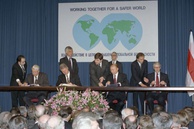Germany and Italy are being urged to move $245 billion worth of US gold reserves to Europe amid "geopolitical instability" and President Donald Trump's criticism of Federal Reserve Chairman Jerome Powell, the Financial Times reports.
In connection with Trump's unpredictable policy, calls for gold export have become more frequent in Europe.
In particular, the Association of European Taxpayers insists on this, having contacted the finance ministries and central banks of Germany and Italy. "We are very concerned that Trump is encroaching on the independence of the Federal Reserve," said the association's president, Michael Jaeger. He stressed that control over gold should belong to European regulators.
Amid fears of a US trade war with the European Union, members of the German Bundestag are increasingly raising the issue of auditing the country’s gold reserves and bringing some of them back home from the US Federal Reserve System (FRS), where they are currently stored.
With Germany’s gold reserves totaling 3,352 tons, the Deutsche Bundesbank (BB) boasts the world’s second-largest gold reserves after the US Federal Reserve. Thirty-seven percent of these, approximately 1,236 tons valued at around €113 billion, are stored in the American central bank's vaults overseas.
Concerns among German politicians intensified following Donald Trump's return to the White House, his protectionist trade policies, and Elon Musk's open support, allegedly with a nod from Trump, for the opposition Alternative for Germany party (AFD).
According to the Zero Hedge online economics blog, one of the main skeptics regarding the security of German gold stored in the US is Bundestag deputy Marco Wanderwitz from the Christian Democratic Union. In 2012, he tried and failed to initiate an audit of the country’s gold reserves, demanding greater transparency from the Bundesbank or the return of the gold to the bank’s headquarters in Frankfurt. In this he enjoys the support of fellow party member Markus Ferber, who currently represents Germany in the European Parliament.
"Representatives of the Bundesbank should personally recount all the gold bars and document the audit results," Ferber stated.
Wanderwitz and Ferber have many supporters, who insist, at a minimum, on a thorough audit of the German gold deposited in a FRS vault located deep under Manhattan Island in New York, and at most, on its return to Germany.
The Bundesbank insists that there is no cause for concern though.
"We fully trust the Federal Reserve Bank of New York and consider it a reliable partner," Bundesbank President Joachim Nagel said at a press conference in February. "I can say that this issue doesn't keep me awake at night," he added.
That said, German supporters of gold repatriation have good reason to be concerned. Americans, just like the British and Swiss, are extremely reluctant to part with gold bars, even if these are not theirs.
The first thing that comes to mind is the 2012 incident, when German central bank employees were denied access to the vaults where Germany's gold is allegedly deposited. The scandal was hushed up at the highest level, for reasons of preserving Euro-Atlantic unity and avoiding conflict with the United States.
In 2013, due to a worsening financial situation, Berlin planned to bring back 50 tons of gold annually from the US until 2020.
However, only 37 tons of the 674 tons requested were delivered to Germany within a year, 33 tons of which came from France. Germany received only five tons of gold from the US, and the process ground to a halt.
The German government was left with no other choice than to acknowledge the "reliable storage of gold reserves in the US and the absence of grounds for mistrust between the countries."
Apparently unconvinced by these assurances, Focus magazine l published an article by J. Felling, suggesting that the sluggish pace of gold repatriation might indicate the absence of gold in the US Federal Reserve System's vaults.
In an earlier FRS-related incident, in 2009, the US Department of Treasury sent a batch of gold bars to China, which later turned out to be counterfeit. The bars that arrived in China were made of tungsten with gold plating and featured forged FRS serial numbers. Skeptics suggest that the German gold stored in the US may have suffered the same fate.
French President Charles de Gaulle’s alleged decision to exchange paper dollars for gold bars has become shrouded in myths and legends. According to them, in 1960, the French government sent out a cruiser loaded with US dollars to American shores with a stern demand that the Americans exchange them for gold. This is not what really happened though.
In November 1964, de Gaulle uttered the now-famous phrase: "Without financial independence, there can be no independence."
De Gaulle was wary of threats to France's financial position from the US and the UK. He was unhappy about the "invasion of Europe by American industry" (de Gaulle was reportedly enraged by Chrysler company’s 1963 acquisition of a controlling stake in the French automaker Simca). There were also concerns about a possible devaluation of the US dollar or the British pound sterling.
In her book, A Gold Battle? De Gaulle and Dollar Hegemony in the Bretton Woods Era, Pennsylvania University researcher Maelis Avaro cites a memo that Jean-Maxime Leveque, a technical advisor to the French president's administration, sent to de Gaulle in June 1962: "If the dollar ceases to be a reliable currency, one must ask oneself whether one should keep reserves in dollars." According to Leveque, the dollar was under strong pressure from slow economic growth and an imbalance in the US balance of payments. In the worst-case scenario, this could lead to a loss of confidence in the dollar and a suspension of the gold convertibility for foreign central banks, i.e. a gold embargo.
On December 23, 1964, Charles de Gaulle met with his Economy and Finance Minister, Valéry Giscard d'Estaing, Prime Minister Georges Pompidou, and Foreign Minister Maurice Couve de Murville. The participants decided to protect France's gold and foreign exchange reserves (GFR) by converting dollars into gold with an eye to bringing down the dollars’ share in the country’s gold reserves to 8 percent.
Back in the day, gold accounted for 73 percent of France's gold and forex reserves, while dollars and other currencies accounted for just 27 percent. In Belgium, Great Britain, and Switzerland, the share of gold in their national GFRs was 90 percent. At the same time, in the Federal Republic of Germany, gold accounted for only 55 percent of GFR, and only 15 percent in Japan. This caused a frown from Paris: "Dollars are for the defeated."
France's first exchange of dollars for gold was perceived in the United States as an attack on the greenback. In a January 1965 article, Time magazine wrote, "Charles de Gaulle, who has long since learned how to use economics as a political weapon, last week hit the US where it hurt: right in its gold reserves. In so doing, he sent shock waves throughout the international monetary system, of which the US is the mainstay, and revived doubts about the system's basic strength and resiliency. The French Ministry of Finance revealed that, following De Gaulle's order, France will convert at least $300 million of its $1.3 billion hoard of dollars into gold—in addition to the $400 million to $500 million it routinely cashes in each year.”
De Gaulle's statement caused concern in the US, not only per se, but also because other countries with large dollar reserves might follow France's example. Speculators reacted to the French president's words with the market price of gold in London starting to rise, and the dollar's exchange rate against the West German mark going down. In a bid to prop up the dollar’s exchange rate, US President Lyndon Johnson announced plans to reduce the minimum legal gold reserve by selling gold on international markets. The Treasury Department issued an unusual statement warning speculators that playing on the price of gold "will inevitably end in loss," and that the $35 per ounce gold price set by the Bretton Woods agreement would remain unshaken.
France's right to exchange dollars for gold remained undeniable though. With the French treasury having a surplus of US currency, the annual cost of maintaining the American military contingent in France was $200 million, American tourists visiting France spent $300 million each year, and American business people invested over $1 billion annually. Taking into account the import of US goods into France, the positive balance in bilateral trade amounted to $700 million.
On January 7, 1965, France exchanged $150 million for gold.
At a February 4, 1965 news conference in Paris, President de Gaulle spoke out in favor of bringing the world financial system back to the gold standard. He stated that the system of international monetary settlements established after World War II, where the US dollar and the British pound enjoyed a privileged position, had lost its relevance, and proposed to start negotiations on revising the Bretton Woods system within the IMF.
"Never before has a head of state launched such an open assault on the monetary power of a friendly nation," Time magazine wrote in response to the French president's new statement.
And what about the French cruiser? Was it there or not? And if not, where did the stories about it come from, after all?
In 1994, Valéry Giscard d'Estaing shared the following story in an interview with the French magazine Revue d'economie financiere: "During his famous press conference, General de Gaulle announced that France intended to convert all its excess dollars into gold. Every month, we returned several tons to the country, in keeping with security regulations in this area. When questioning me, the General said he wondered why things were moving so slowly. He suggested that I dispatch the cruiser Colbert to New York and load all our gold, demanding that from the Americans. Imagine the effect that the arrival of a warship would have had… Fortunately, we managed to avoid that."
Well, France was indeed bringing back its gold deposited in the US. And from Britain too. In the early 1960s, the French gold reserves were almost equally distributed among three financial centers – New York, London, and Paris. In the autumn of 1963, they started transporting French gold from New York to London and directly to Paris. After de Gaulle's speech calling for a gold standard, the speed of gold being moved back to France increased, and in 1966, 90 percent of France's gold reserves were already in Paris.
Until January 1965, gold was transported by ships (but not warships). In January, General de Gaulle told Prime Minister Pompidou that all the gold should be returned home, leaving only the necessary minimum abroad. After Giscard d'Estaing dissuaded de Gaulle from the idea of sending out the cruiser, the Bank of France had to use Air France passenger and cargo planes to move the gold across the ocean.
According to documents from the Bank of France archives, a total of 2,934 tons of gold were delivered to Paris, with the entire cost of the transportation operation totaling $4.2 million.
read more in our Telegram-channel https://t.me/The_International_Affairs

 14:01 23.06.2025 •
14:01 23.06.2025 •



























